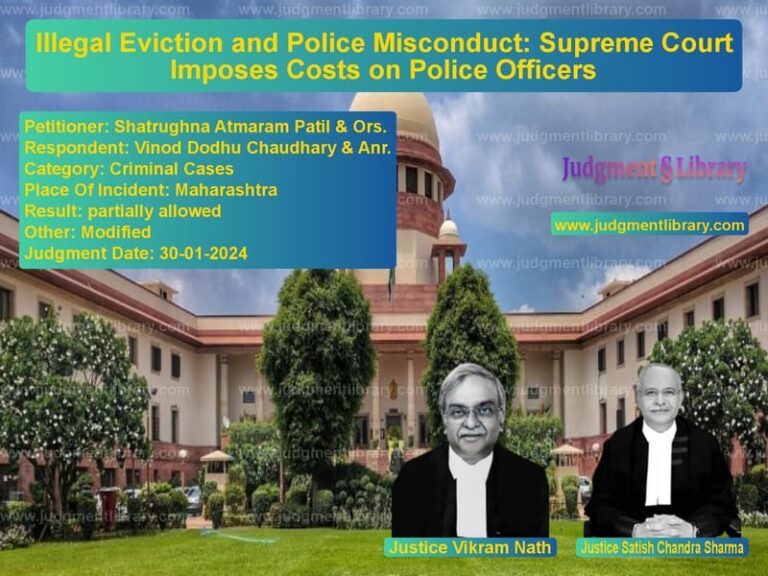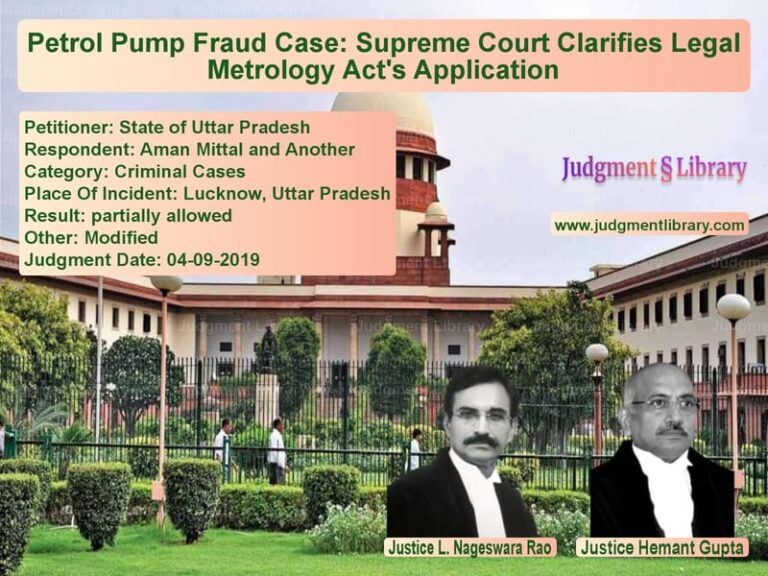Supreme Court Upholds Death Sentence in Heinous Child Rape and Murder Case
The Supreme Court of India recently ruled on a deeply distressing case involving the rape and murder of a minor child. In the case of Abdul Nassar vs. State of Kerala, the accused was convicted of raping and murdering a 9-year-old girl and was sentenced to death. The case is significant for its reliance on forensic evidence and circumstantial proof in determining the guilt of the accused. The Supreme Court ultimately upheld the decision of the lower courts, reaffirming the death penalty.
The horrific crime occurred on April 4, 2012, when the victim, a 9-year-old girl, was on her way to Madrassa. She stopped at the house of the accused to call his daughter, who was her friend. Finding the child alone, the accused took advantage of the situation, committed sexual assault, and subsequently strangled the victim to death. He attempted to hide the crime by concealing the body within his house before ultimately moving it to the bathroom.
Sequence of Events Leading to the Conviction
The following sequence of events summarizes how the case unfolded:
- 6:30 AM: The victim left home for Madrassa.
- 7:00 PM: Her family reported her missing.
- 7:30 PM: Her body was discovered in the bathroom of the accused’s house.
- April 6, 2012: The accused was arrested.
- July 31, 2013: The trial court sentenced the accused to death.
- February 28, 2018: The Kerala High Court upheld the conviction and death sentence.
- January 7, 2025: The Supreme Court dismissed the appeal, affirming the conviction.
Prosecution’s Case and Evidence
The prosecution presented a strong case against the accused, relying on forensic evidence and eyewitness testimony. Some of the key pieces of evidence included:
- Forensic Analysis: Blood stains were found on the cot and the floor of the accused’s house, matching the victim’s DNA.
- DNA Evidence: Seminal stains on the victim’s clothing and vaginal swabs matched the DNA of the accused.
- Recovery of Belongings: The victim’s school bag and slippers were recovered from the accused’s house.
- Autopsy Report: The medical report confirmed that the victim had suffered severe sexual assault before being strangled to death.
Defense Arguments
Senior Advocate Trideep Pais, representing the accused, challenged the conviction on several grounds:
- Contamination of Evidence: The crime scene was left unsealed for hours, raising the possibility of tampering.
- Access to the Crime Scene: The bathroom where the body was found was in an open area, accessible to others.
- Break in Chain of Custody: The defense questioned the proper handling and transfer of forensic evidence.
- Lack of Direct Witnesses: The case was based purely on circumstantial evidence, with no eyewitness to the crime.
Prosecution’s Counterarguments
Senior Advocate R. Basant, representing the State, countered these claims with the following arguments:
- Clear DNA Match: The DNA found on the victim’s clothing and body matched the accused beyond doubt.
- Bloodstains and Semen Evidence: Forensic examination confirmed that the accused was in close contact with the victim at the time of the crime.
- Incriminating Conduct: The accused initially denied knowledge of the victim’s whereabouts and was later found attempting to mislead investigators.
- Last Seen Principle: The victim was last seen heading towards the house of the accused, which was near her Madrassa.
Supreme Court’s Observations
The Supreme Court reviewed the evidence extensively before delivering its final ruling. The Court reiterated the principle that circumstantial evidence must form a complete chain leading only to the accused’s guilt. The judgment cited:
“The circumstances from which the conclusion of guilt is to be drawn should be fully established. There must be a chain of evidence so complete as not to leave any reasonable ground for a conclusion consistent with the innocence of the accused.”
The Court noted that all evidence, including forensic reports, DNA analysis, and medical examination, pointed conclusively to the accused’s guilt. It held that there were no mitigating circumstances warranting a lesser sentence.
Final Judgment
The Supreme Court upheld the death sentence, classifying the case as one of the ‘rarest of rare’ crimes. The judgment emphasized that the brutality of the act and the vulnerability of the victim justified the most severe punishment. However, since the accused passed away during the appeal process, the execution of the death penalty was rendered unnecessary.
Key Takeaways from the Judgment
- This case sets an important precedent for the use of forensic DNA evidence in criminal trials.
- The judgment reinforces the importance of circumstantial evidence in securing convictions.
- The ruling highlights the judiciary’s firm stance against crimes involving child sexual abuse and murder.
The case serves as a significant example of the judicial system’s role in delivering justice in cases of extreme brutality. By upholding the death penalty, the Supreme Court has sent a strong message regarding the severity of crimes against children and the legal consequences they entail.
Petitioner Name: Abdul Nassar.Respondent Name: State of Kerala & Anr..Judgment By: Justice B.R. Gavai, Justice K.V. Viswanathan, Justice Sandeep Mehta.Place Of Incident: Ponnamkallu, Amarambalam Village, Kerala.Judgment Date: 07-01-2025.
Don’t miss out on the full details! Download the complete judgment in PDF format below and gain valuable insights instantly!
Download Judgment: abdul-nassar-vs-state-of-kerala-&-an-supreme-court-of-india-judgment-dated-07-01-2025.pdf
Directly Download Judgment: Directly download this Judgment
See all petitions in Murder Cases
See all petitions in Rape Cases
See all petitions in Juvenile Justice
See all petitions in Judgment by B R Gavai
See all petitions in Judgment by K.V. Viswanathan
See all petitions in Judgment by Sandeep Mehta
See all petitions in dismissed
See all petitions in supreme court of India judgments January 2025
See all petitions in 2025 judgments
See all posts in Criminal Cases Category
See all allowed petitions in Criminal Cases Category
See all Dismissed petitions in Criminal Cases Category
See all partially allowed petitions in Criminal Cases Category







